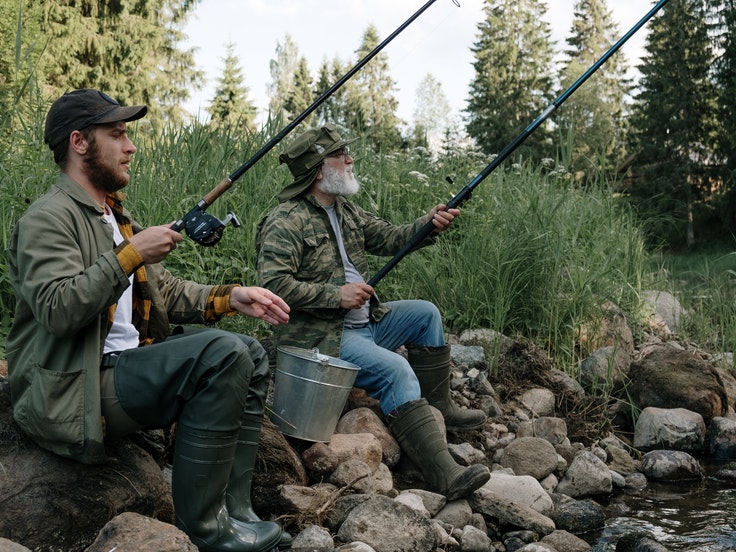
Certainly one of the most difficult aspects of casting reels to master, casting is almost an art. With technique and practice, you'll eventually master how to use your rod and double crank to cast your lures to centimetre accuracy.
To do this, you'll need to understand the technology behind your reel. You'll need to understand how your drag works, what exactly happens under the frame when your line comes out. Spool speed will become a real obsession if you want to avoid wigs.
Once you've mastered this technical concept, you'll have to get to grips with the adjustment. The large number of knobs can be impressive at first, but after a few manipulations in the garden or in your swimming pool, any angler will be able to gain in precision.
You'll then need to master the practical part, and get 20 to 30 metres of line out on a single flick of the wrist. You'll need to learn how to position your finger, let the shaft rotate and know how to slow down the rotation before touching the water. At this point, you'll appreciate the quality of each roll and the quality of the rings.
All that's left is to practise as often as you can, and you'll quickly become more comfortable, and you won't have to worry too much about the size of your lures. Different fishing techniques are possible, whether you're looking for fish like trout with a baitfinesse or pike with a big bait.
How does it work?
This type of reel is called a spinning reel. This is because the spool rotates during the casting phase. These fishing techniques involve disengaging the clutch and giving a push with your casting rod. Your fishing lure will then go more or less far.
It is this rotation of the spinning reel that needs to be managed to achieve the casting distance that every angler wants. To do this, you can rely on a braking system that you'll have to adjust yourself for almost every lure.
To do this, you need to press a specific button. This is generally a tightening and loosening adjustment. It will leave the spool more or less free to turn when casting. The tighter you tighten it, the less free the spool is and vice versa.
Depending on the weight of your lure, you can alternate between tightening it more or less. You'll also find precision knobs on some casting reels that allow you to adjust more easily while fishing. They also allow you to fine-tune your lure according to the wind conditions you encounter or the fishing techniques you use.
There are currently two main friction braking systems. You'll regularly see magnetic or centrifugal. The first is managed by an external selector system, which is fairly easy to understand, while the second requires adjustment inside the frame by moving weights.
An impressive first experience.
It's not always easy to get to grips with your first combo casting. The reel is up, the rings are up and you realise that you don't need your second hand to cast. It's confusing ... but it doesn't last long.
Now that you've understood the system and the technology behind your first purchase, all you have to do is practise. Of course, you're worried that your line will suddenly jump out of the frame at the first cast and that you'll make the wig of the century, knocking out 135m of brand new braid.
So here are a few tips and tricks to ensure you don't find yourself at a loss the first time you use it and have a chance of adopting this technique:
- Your first line should be nylon and preferably of a fairly large diameter. This will prevent knots and make it easy to untie.
- Tighten the friction brake at the start, and only loosen it as you become more comfortable with your casts.
- Take the time to learn. Don't get discouraged. If you understand how the mechanics work, the line will eventually come off the spool and you'll be able to achieve outstanding skill in no time.
Once you've calmed down, we invite you to make your first adjustment. It couldn't be simpler. You need to put a lure on your line (preferably a big one to start with). Tighten your spool knob all the way and hold your rod horizontally.
Then unhook the spool and let the lure sink to the ground. The lure should then descend very slowly and the spool should stop spinning when the lure touches the ground. Once you've reached this setting, you're ready to cast!
The subtleties that can make all the difference
The size of your line body is often a problem when you first start fishing. Thin diameters, especially if you've opted for 8 strands, are difficult to master. For your first few weeks, opt for a larger diameter and try to stick with 4-strand line, which may be noisy and less comfortable, but is less likely to cause problems.
Choose to start with high weights. If you don't want your spool shaft to get carried away because you're using too much force with a small lure, start with at least 10g, or even a little more. You'll find it easier to become automatic if you spend less time untying knots. You'll get the hang of the knobs, the double crank and the clutch.
Finally, you'll need to learn to use your thumb. This will enable you to take over from a spool bearing that can sometimes get carried away. This will make it easier for you to control the speed of rotation from the beginning to the end of the cast.
Once you've got the hang of it, you'll soon be able to get out on the water and land your first casting fish, and why not a nice big-bait pike?
Our other articles on casting reels :
